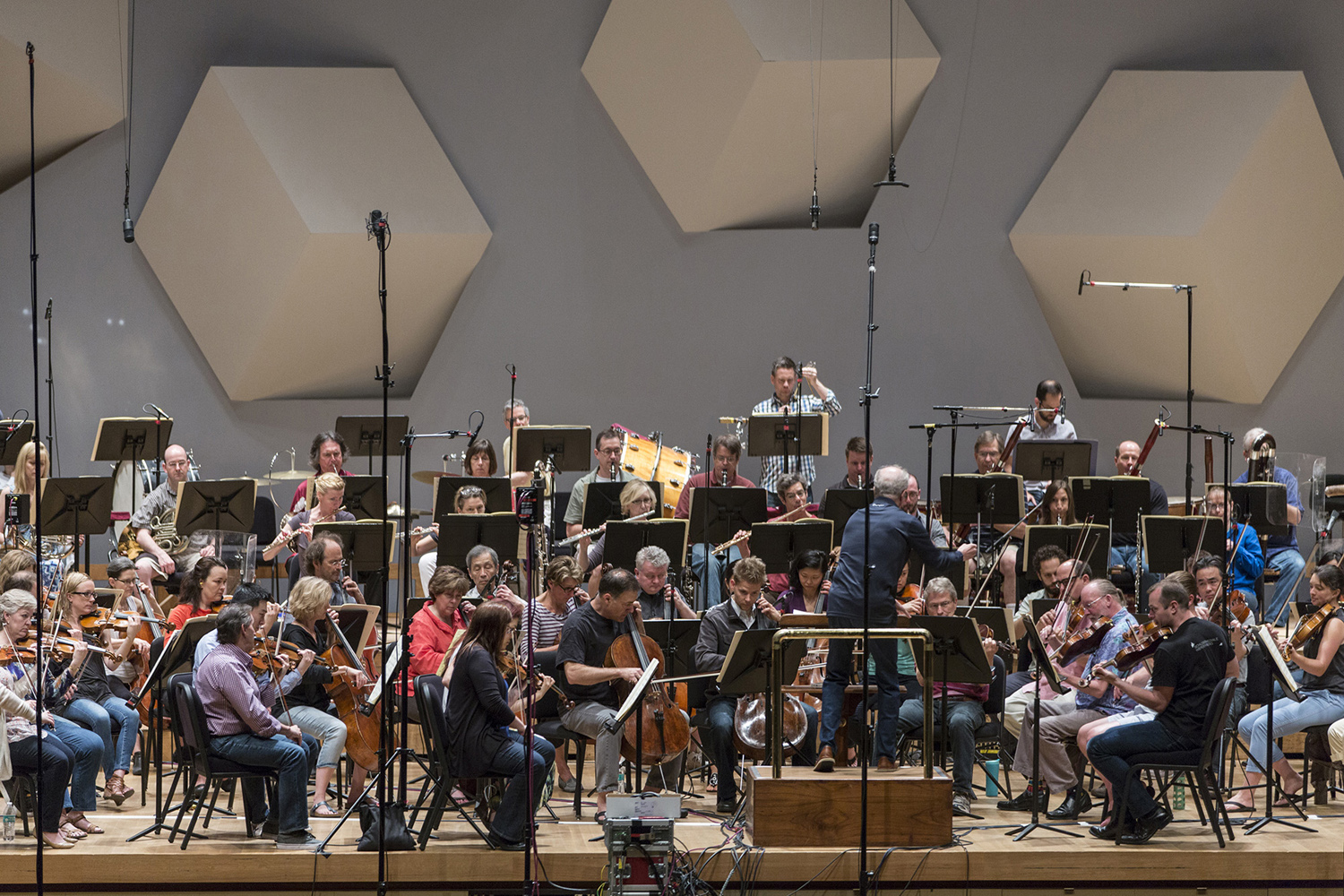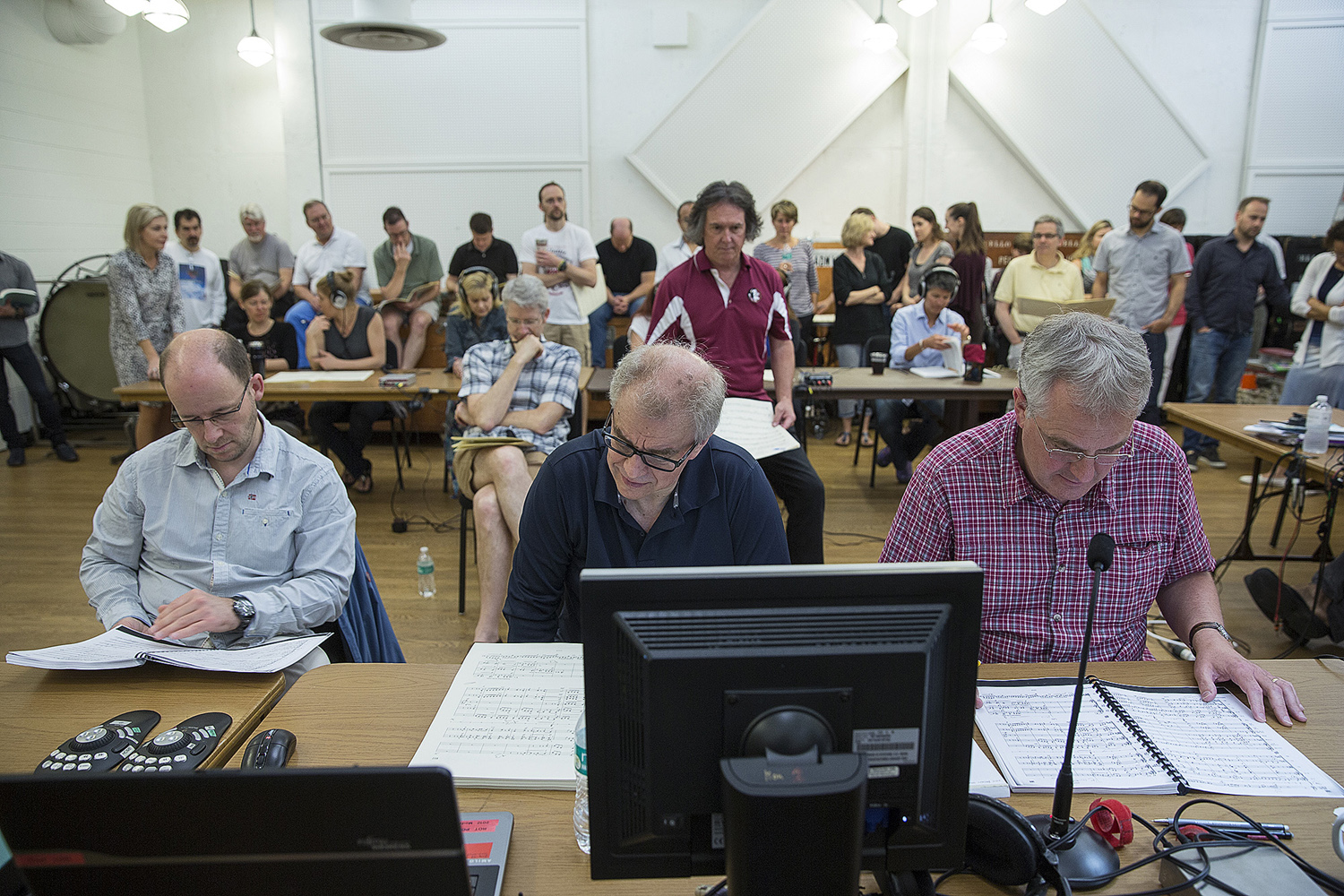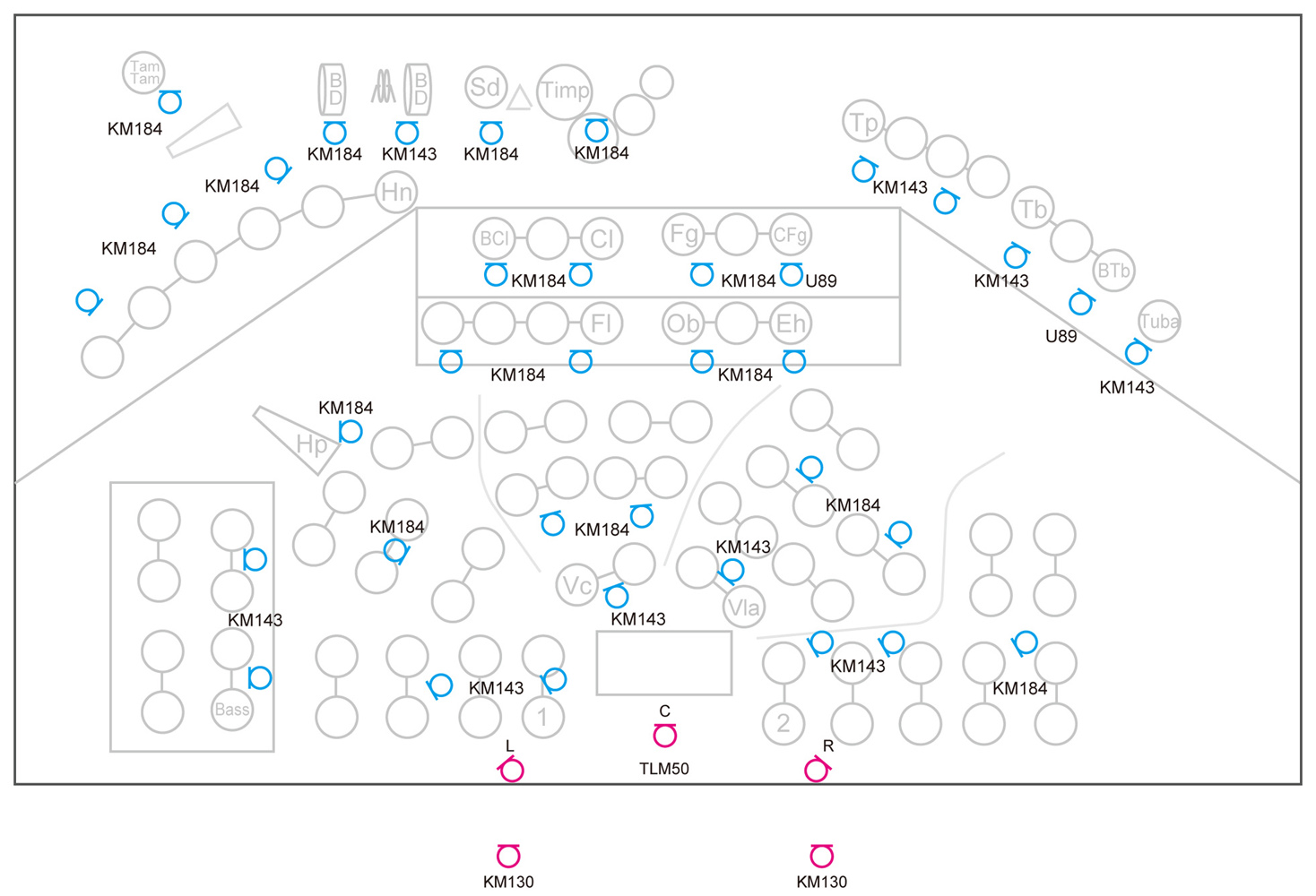Nagoya University of the Arts
Overview:
I visited BIS Records (BIS), a classical music label in Åkersberga, northeast of Stockholm, Sweden in November, 2016. A while before this visit, in August 2013, I had an opportunity to meet with Mr. Thore Brinkmann, one of the Tonmeisters of Take5 Music Production that takes care of BIS’s recording production, during the session recording of Bach Collegium Japan (BCJ), conducted by Masaaki Suzuki, at Shirakawa Hall in Nagoya, Japan. Since then, I have been interacting with him and looking for a chance to visit the headquarters of BIS, and when I traveled to Europe for Tonmeistertagung Cologne, I finally had an opportunity to visit the headquarters of BIS. In this article, I would like to report about the history and outline of BIS, recording production cases by BIS and Take 5 Music Production, and the mail interview in July 2017.
The history of the BIS Records:
Founded by Robert von Bahr in 1973, BIS is a classical music record label that covers a wide range of music from contemporary music to medieval music. The label has produced approximately 2,300 titles. Their products include a 55-disc series of Bach's sacred cantatas by Bach Collegium Japan, a 68-disc complete Edition of Finnish composer, Sibelius, and many other products focusing on Nordic conductors and modern composers of other countries. It is a unique label unlike any other in the world.
Attracting classical music fans from around the world, the label releases 5 new titles in a month (60 new titles in a year) on physical medium, mainly on stereo and surround hybrid SACDs, and by digital distribution on their website and all other big sites as well.
Born in 1943, Mr. von Bahr, the founder of BIS, is 75 years old now. Having studied music education at Stockholm Music College, he studied law at the University of Stockholm, and began his career as a recording engineer at the Royal Stockholm Philharmonic Orchestra in 1968. After he became a recording producer in 1970, he established BIS in 1973 and has been serving as the CEO ever since.
When I had talked with him for a few minutes, I started to feel as if he had been an old friend of mine for a number of years even though I was meeting with him for the first time. Furthermore, as I had a conversation with him, I could feel his enthusiasm and respect to music as well as his calmness for operating a record label.
Content of BIS’s very first product, released with the serial number, BIS LP-1, in January 1974, was Jewish liturgical music for baritone, organ, flute, etc. and choir. In the credit of this album, there is a description that Mr. von Bahr himself recorded it with Scotch 206 tape, a tape recorder Revox A-77 (38 cm/sec), and two Sennheiser MKH 105 microphones. BIS’s currently released SACDs also have notes on recording equipment, including microphones, ADC/DAC, original format, etc. Having this kind of note is common for BIS’s products from its very first product, and this indicates that BIS is aiming for the sound quality that attracts not only music fans but also recording enthusiasts. Mr. von Bahr told me that BIS releases its product in a high quality and practical format of at the time, and indeed, its first product, BIS LP-1 was released as an LP in 1974; its first product on CD, The Kroumata Percussion Ensemble, BIS-232, was released in January, 1983; and its first product on SACD, TAKEMITSU: How Slow the Wind, BIS-1078, was released in January, 2001. Furthermore, in 2016, BIS started a service to digitally distribute music in 96kHz/24bit FLAC stereo/surround sound on its own music distribution website, "eClassical" (http://www.eclassical.com), which was originally established in 1999, taken over completely by BIS, one of its original shareholders, in 2012
Mr. von Bahr said that the BIS's first recording was carried out by himself alone, and I asked him "How did you learn the production and recording method?" His answer simple, "Doing Studying"(= learning while doing). Answering to my question, "What was the reason for the establishment of the label?", he jokingly said "Flute player of this record was my wife at the time, and my purpose was to release a recording of my wife’s performance." It seemed that it is a joke to me, but it was not. Considering his stories with full of humor and the history of BIS, I assume that there is an idea, he wanted to record musical content that no one has never worked on and in high quality sound and to deliver it to listeners, in a principle of the label.
BIS Records :
 |
| BIS Headquarter |
The history of the BIS Records:
Founded by Robert von Bahr in 1973, BIS is a classical music record label that covers a wide range of music from contemporary music to medieval music. The label has produced approximately 2,300 titles. Their products include a 55-disc series of Bach's sacred cantatas by Bach Collegium Japan, a 68-disc complete Edition of Finnish composer, Sibelius, and many other products focusing on Nordic conductors and modern composers of other countries. It is a unique label unlike any other in the world.
Attracting classical music fans from around the world, the label releases 5 new titles in a month (60 new titles in a year) on physical medium, mainly on stereo and surround hybrid SACDs, and by digital distribution on their website and all other big sites as well.
Born in 1943, Mr. von Bahr, the founder of BIS, is 75 years old now. Having studied music education at Stockholm Music College, he studied law at the University of Stockholm, and began his career as a recording engineer at the Royal Stockholm Philharmonic Orchestra in 1968. After he became a recording producer in 1970, he established BIS in 1973 and has been serving as the CEO ever since.
When I had talked with him for a few minutes, I started to feel as if he had been an old friend of mine for a number of years even though I was meeting with him for the first time. Furthermore, as I had a conversation with him, I could feel his enthusiasm and respect to music as well as his calmness for operating a record label.
 |  |  |
| All of CD and LP | BIS LP-1 | |
 |  | |
| CEO, Robert von Bahr | BIS LP-1 | Young CEO, Robert von Bahr |
Mr. von Bahr said that the BIS's first recording was carried out by himself alone, and I asked him "How did you learn the production and recording method?" His answer simple, "Doing Studying"(= learning while doing). Answering to my question, "What was the reason for the establishment of the label?", he jokingly said "Flute player of this record was my wife at the time, and my purpose was to release a recording of my wife’s performance." It seemed that it is a joke to me, but it was not. Considering his stories with full of humor and the history of BIS, I assume that there is an idea, he wanted to record musical content that no one has never worked on and in high quality sound and to deliver it to listeners, in a principle of the label.
BIS Records :
Currently, BIS Records is operated with seven people. When I visited its office, Robert von Bahr, founder/CEO, Robert Suff, a music producer, Matthias Spitzbarth, a Tonmeister, Leif Hasselgren, a booklet editor, and other staffs such as production coordinators and finance managers were at work in the office.
Mr. Suff, the music producer, was originally a conductor from UK and has been serving as a music producer at BIS from 1989. He has produced productions with Minnesota Orchestra, BBC National Orchestra of Wales, Kent Nagano, and many others.
Mr. Spitzbarth, the Tonmeister, is an alumnus of the Detmold University of Music and is the only specialist in sound recording techniques at BIS. He also serves as a balance engineer, while working on editing, mixing, and mastering, so he is a soundmaster of BIS. He checks qualities and controls sound of almost all BIS products.
Mr. Hasselgren, the booklet editor, works on art works of jackets and production and media relations.
Mr. Suff, the music producer, was originally a conductor from UK and has been serving as a music producer at BIS from 1989. He has produced productions with Minnesota Orchestra, BBC National Orchestra of Wales, Kent Nagano, and many others.
Mr. Spitzbarth, the Tonmeister, is an alumnus of the Detmold University of Music and is the only specialist in sound recording techniques at BIS. He also serves as a balance engineer, while working on editing, mixing, and mastering, so he is a soundmaster of BIS. He checks qualities and controls sound of almost all BIS products.
Mr. Hasselgren, the booklet editor, works on art works of jackets and production and media relations.
 | 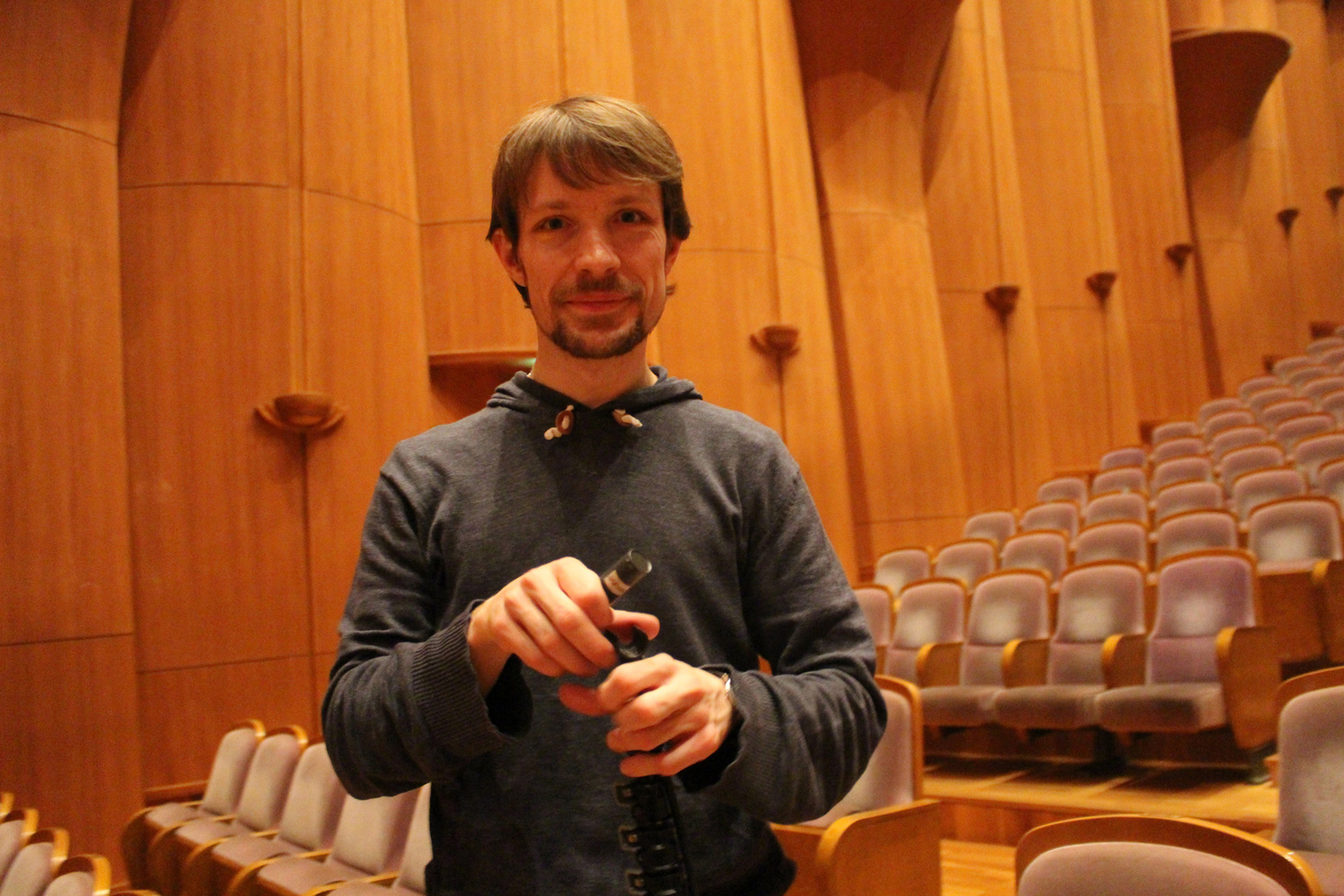 |  |
| Music Producer, Robert Suff | Tonmeister, Matthias Spitzbarth | Booklet Editor, Leif Hasselgren |
Take 5 Music Production :
 In 2013, Take5 Music Production was founded by 5 Tonmeisters, Hans Kipfer, Ingo Petry, Jens Braun, Marion Schwebel, and Thore Brinkmann, who had been serving for recordings and productions of BIS.
In 2013, Take5 Music Production was founded by 5 Tonmeisters, Hans Kipfer, Ingo Petry, Jens Braun, Marion Schwebel, and Thore Brinkmann, who had been serving for recordings and productions of BIS.According to the Take5’s website, “With the formation of Take5, this co-operation will continue alongside the license to now offer Take5’s services and expertise to other labels and artists and expand the range of recording genres covered.
The idea is; in addition to continuing the core work of recording, to help musicians and orchestras find ways of presenting and advertising themselves through all possible modern channels. This can include download platforms, founding their own labels, advertising clips and/or films in HD quality, all tailored to meet the challenging market of rapidly declining physical distribution possibilities.”
I imagine that this is a similar case as the case that recording team of Philips Classics became Polyhymnia International and that the recording team of Deutsche Grammophon became Emil Berliner Studios.
However, there are two remarkably different points between the case of Take5 and these other two cases. One is that BIS still has its own Tonmeister, Mr. Spitzbarth, who serves as the only in-house Tonmeister and is responsible for quality control of its sound products. He has played a role as digital editor in productions of some of the BIS’s products, and he does mixing, mastering, and quality checks besides other tasks. He also plays a role as a balance engineer in productions of certain BIS products, including the production of Missa solemnis, reported below. Another is that BIS still carries out so many recordings every year, that they have decided not to sell their equipment. On the contrary BIS has recently invested in new equipment mostly dedicated for the recordings with the Minnesota Orchestra. On the other hand Take5 has a general contract to use, maintain, develop, and manage BIS' equipment, including world-wide logistics. This proves a close relationship and mutual trust between BIS and Take5. For their own increasing investments Take5 have taken into account that many recordings now involve live concerts and video. When Take5 are hired as both sound or video producers there is often a need to bring essential equipment like special microphones, cameras, and their DAW.
 | ||||
| Hans Kipfer | Ingo Petry | Jens Braun | Marion Schwebel | Thore Brinkmann |
Recording System :
Production of a recording of classical music requires an acoustic space that is most suitable for the music to be recorded, so a mobile recording system is necessary. Heavy users of RME, BIS and Take5 use MAGIX Sequoia DAWs, and MADIface XT portable audio interfaces, and they own 13 Micstsys (HA/ADC), 18 Octamic XTCs, and 14 Madiface XTs. Their recording format is 96kHz/24bit surround. Their equipment is preserved in the United States, Australia, and Japan as well as at their headquarters in Sweden so that they do not have to carry the equipment every time they have a recording. I asked Mr. Brinkmann about the transition of their equipment to the date, and according to him, they used to use Studer 962 consoles in the old days. Their recorders had changed from Sony DAT to Genex GX 8500, to Digidesign Digi 002, and they have been using the current system since 2005.
 |  | 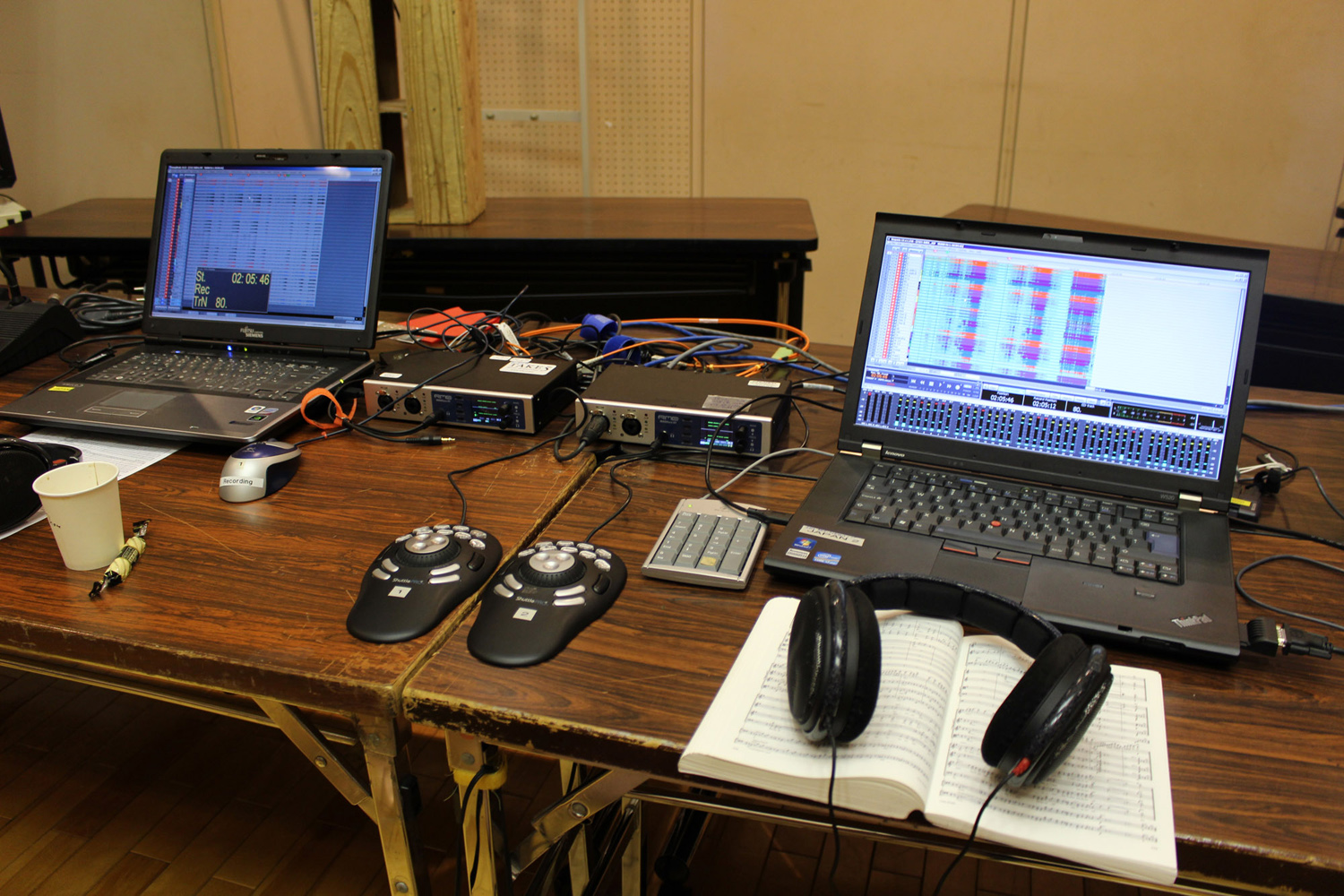 |
| RME OctaMic XTC and OctaMic II | RME Madiface XT and Magix Sequoia | Recording system in the Control Room |
Studio :
BIS has 3 studios for editing, mixing and mastering in its headquarters. One is a surround room, equipped with B&W 802 Diamond, MAGIX Sequoia DAW, YAMAHA 02R 96 console, EMM Labs DAC 8 MK IVs, a Lexicon 960 L, and Avid Artist Mix, and mastering of SACD is processed in this studio. The other 2 studios are PCM stereo rooms, equipped with B&W Matrix 801(Studio1) and QUAD ESL-63(Studio2) speakers, MAGIX Sequoia DAW, and Avid Artist Mix.
 | 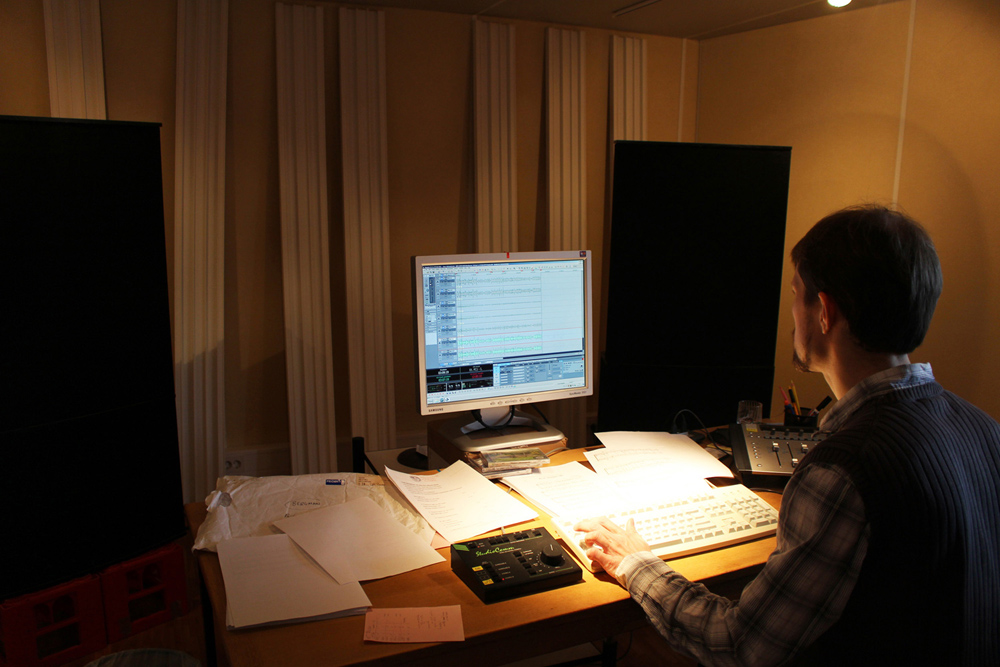 | 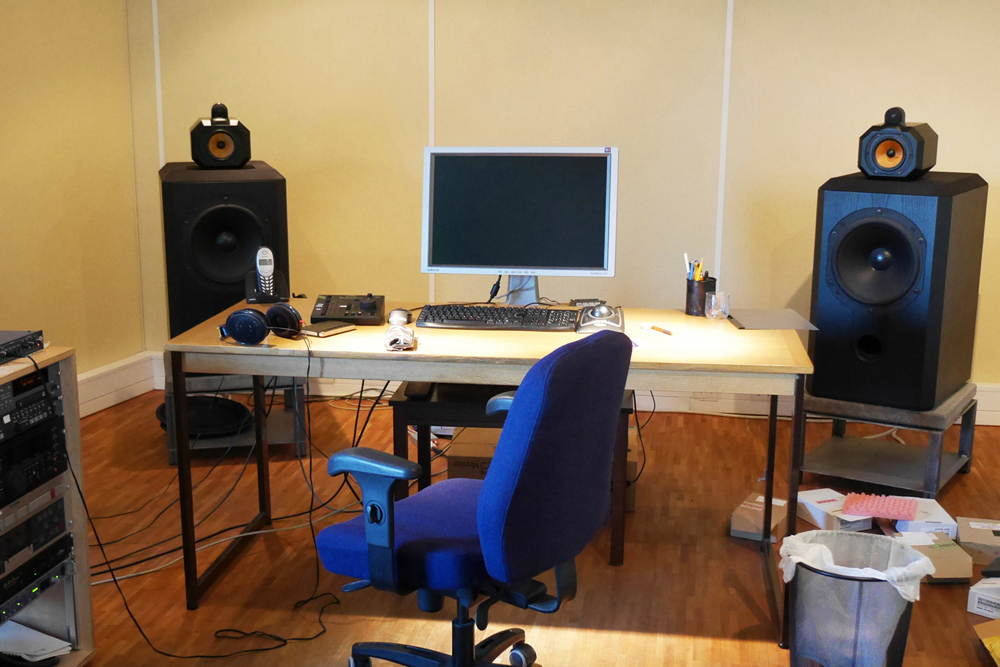 |
| Studio3 | Studio1 | Studio2 |
The Recording :
Case 1
Mahler : Symphony No. 5
Minnesota Orchestra, Osmo Vänskä, conductor
BIS Records BIS-2226 SACD |
A session recording of the Mahler’s Symphony No. 5, performed by the Minnesota Orchestra and conducted by Osmo Vänskä, took place for 3 days at the Minneapolis Orchestra Hall in June 2016. This recording was supervised by Mr. Robert Suff, a producer of BIS, and Thore Brinkmann, a balance engineer of Take5.
As stage boxes, 6 RME Octamic XTC were setup on the stage, and audio signals were transferred to the control room by the SC optical cable and recorded through the Audio interface and RME MADIface XT in the 96 kHz/24 bit surround format by DAW MAGIX Samplitude .
As for the microphone arrangement, the main microphones were Neumann TLM50 for LCR and Neumann KM130 for AB, and the spot microphones were Neumann KM143s and KM184s for the strings, KM184s for the woodwinds, Neumann KM143s for the brass, and U89s for low brass and woodwinds. Cardioids and wide-cardioids were used properly depending on the section. Placement of the microphones was as shown in the figure.
They have recorded Mahler’s Symphony No.6 in November 2016 and Symphony No. 2 in June 2017, and further recordings are continued to be scheduled.
Case 2
J.S. Bach English Suites BWV 806-811
Bach Collegium Japan, Masaaki Suzuki
BIS Records BIS-2281 SACD
Preliminary release date soon
Hybrid SACD Amazon com Download eclassical |
A session recording of J.S. Bach's English Suite by Mr. Masaaki Suzuki, Cembalo took place in a chapel at Kobe Shoin Women’s University for 5 days in August 2016. The recordings was supervised by Mr. Thore Brinkmann, producer/engineer of Take5.
The recording equipment was HA/ADC RME OctamicXTC, set nearby the Cembalo and audio signals were MADI transferred to the waiting room behind the chapel by SC optical cable and recorded through Audio I/F RME MADIface XT and DAW MAGIX Samplitude.
As for microphone arrangement, main microphones were Schoeps CCM 2 H (Omni 12 kHz 2 dB +) for LCR and Neumann KM 143 (Wide Cardioid) for LS/RS, and spot microphones were Microtech Gefell M 950 (Wide Cardioid). Placement of the microphones was shown in the figure x.
LS/RS was a specially arranged to record the sound reflected by a thin wooded board and placed outside the arrangement imitating the general ITU-R surround.
According to Mr. Brinkmann, placing the LS/RS in a common way high up facing away from the Cembalo was not creating the desired effect, because in the large space diffuse echo was overpowering both the direct sound from the instrument and any possible early reflections. Consequently, he set a pair of wooden boards near the floor thereby partly creating a smaller space and recorded the sound reflected by the board with the Neumann KM 143 wide cardioid. I actually listened to the sound and felt that it was a very suitable sound and that this arrangement was one of the ways to get diffused sound with early reflection.
 |  | 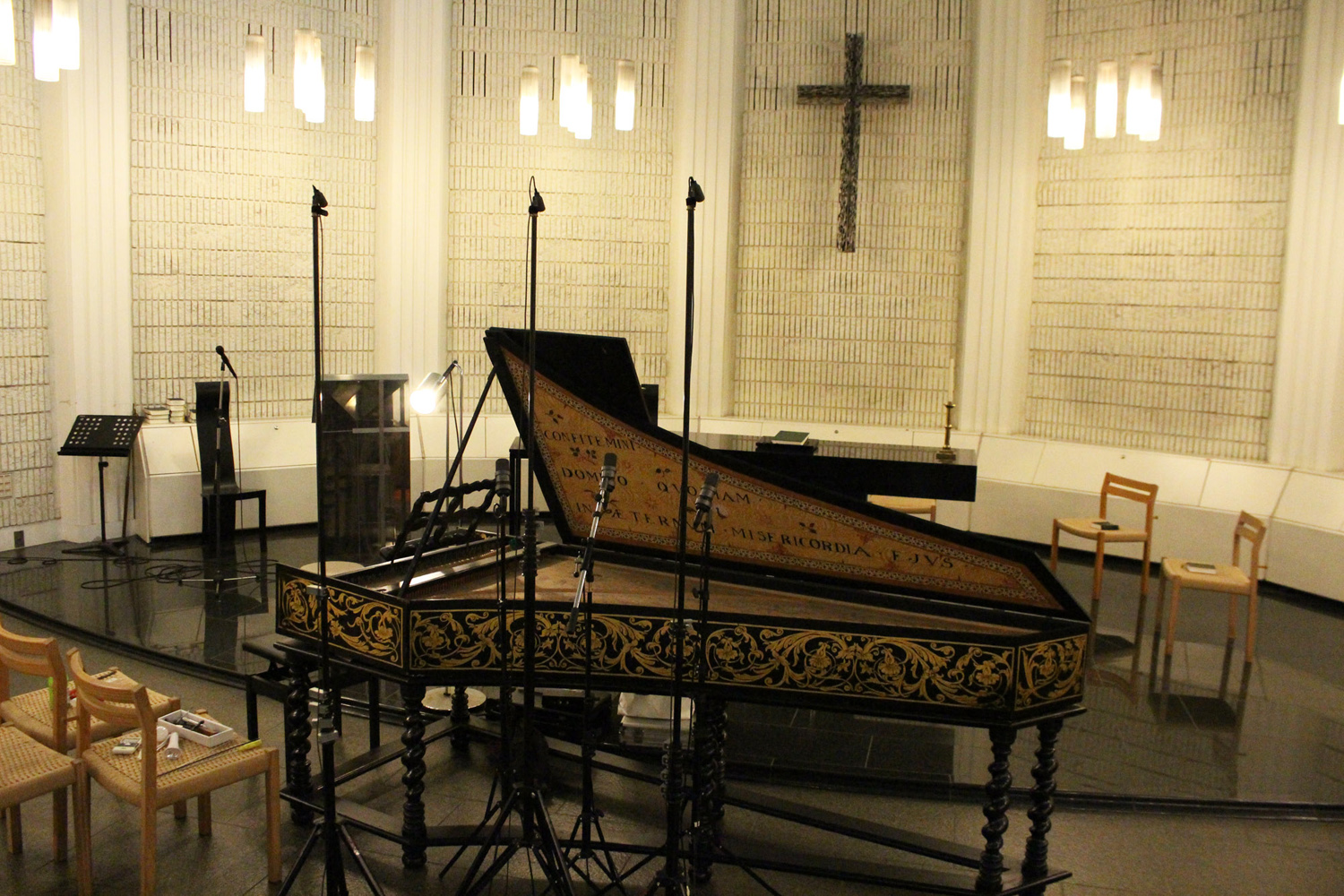 |
| Chapel at Kobe Shoin Women’s University | Masaaki Suzuki plays Cembalo | Main mic and Spot mic of the Cembalo |
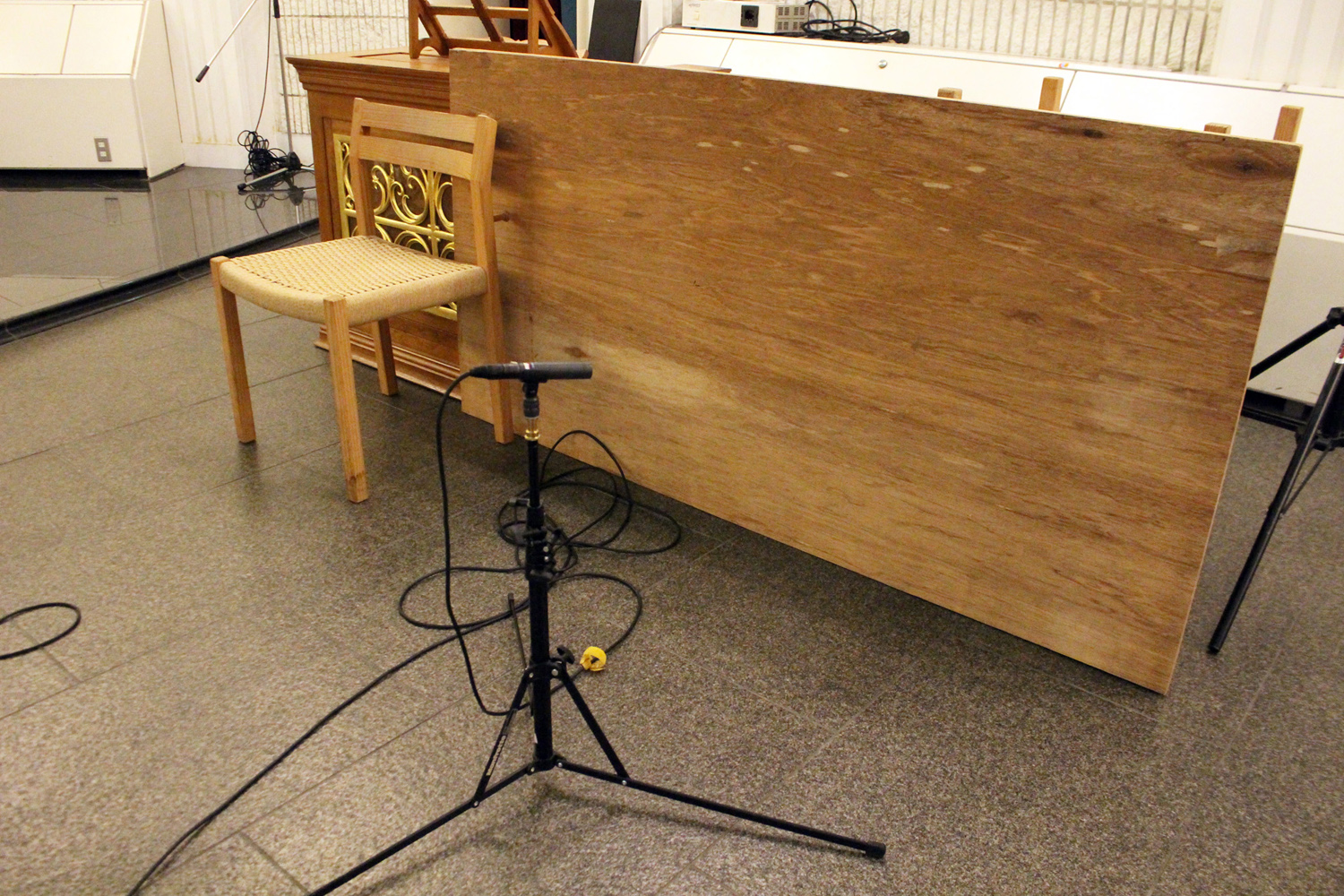 | 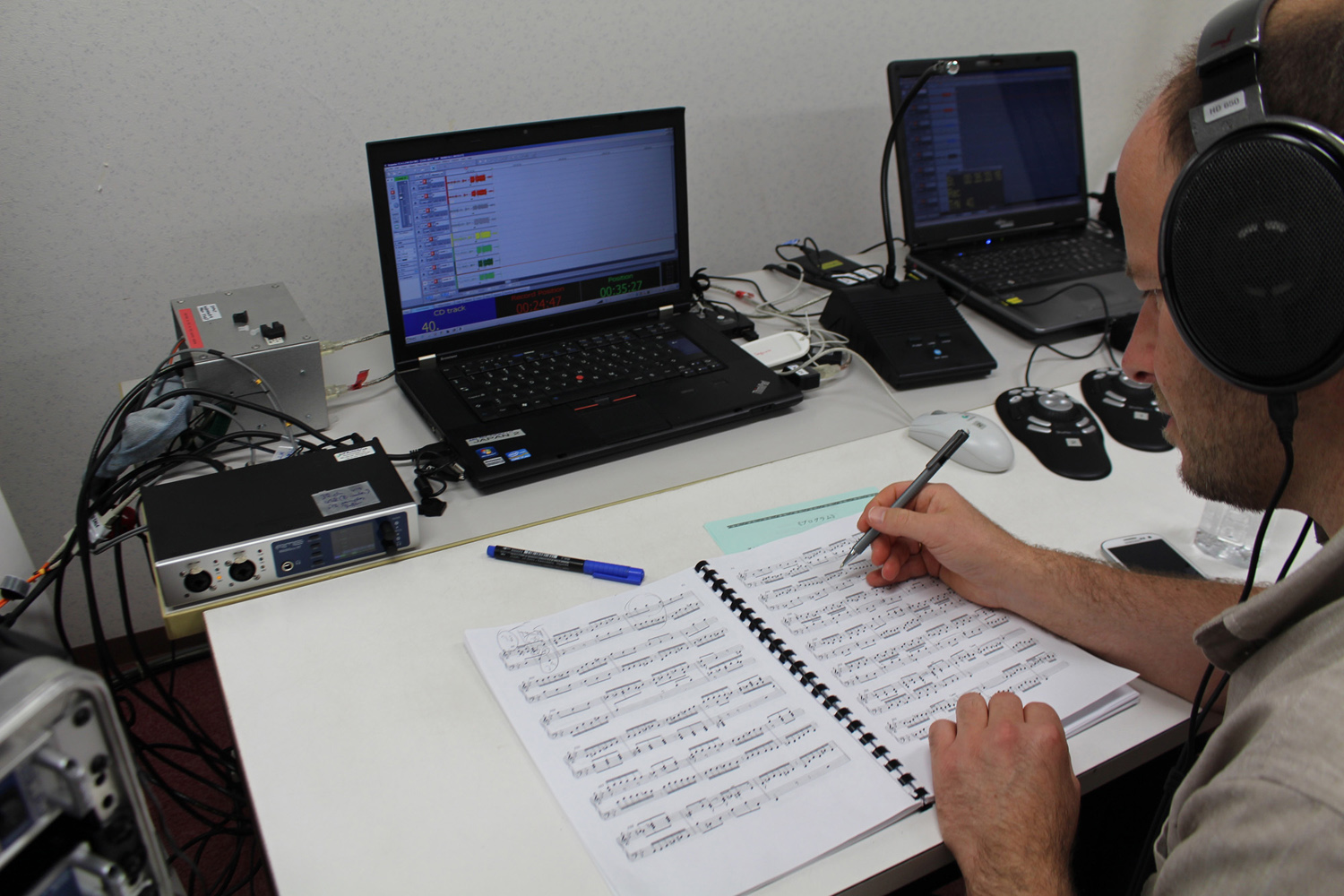 |  |
| Reflection wood panels of Surround RS | Tonmeister, Thore Brinkmann | Set Up |
Case 3
Beethoven – Missa solemnis
Bach Collegium Japan, Masaaki Suzuki
BIS Records BIS-2321 SACD |
A session recording of Beethoven’s Missa solemnis, performed by Bach Collegium Japan and conducted by Suzuki, took place at Kawaguchi Cultural Center Lilia for 4 days in January 2017. The recording was supervised by Mr. Thore Brinkmann, a producer of Take5, and Mr. Matthias Spitzbarth, a balance engineer of BIS.
5 HA/ADC RME Octamic XTC were set near the main microphone and back of the stage. Audio signals were MADI transferred to the dressing room behind the stage by the SC optical cable and recorded through Audio I/F RME MADIface XT and DAW MAGIX Samplitude.
As for the microphone arrangement, main microphones were Schoeps CCM 2 H (Omni 12 kHz 2 dB +) for LCR and Neumann KM 130 for AB, and spot microphones were Neumann KM 143 (Wide Cardioid) and Geffel M 950s for SATB vocal soloists, Neumann KM 140s (Cardioid) and Neumann KM 142s (Open Cardioid), which has not yet been released, for the strings, Neumann KM 184s and TLM 170s for the woodwinds, and Neumann KM 143s (Wide Cardioid) for the choir. There was surround LS/RS, but AB is assigned to LS/RS in surround. (See interview)
 |  | 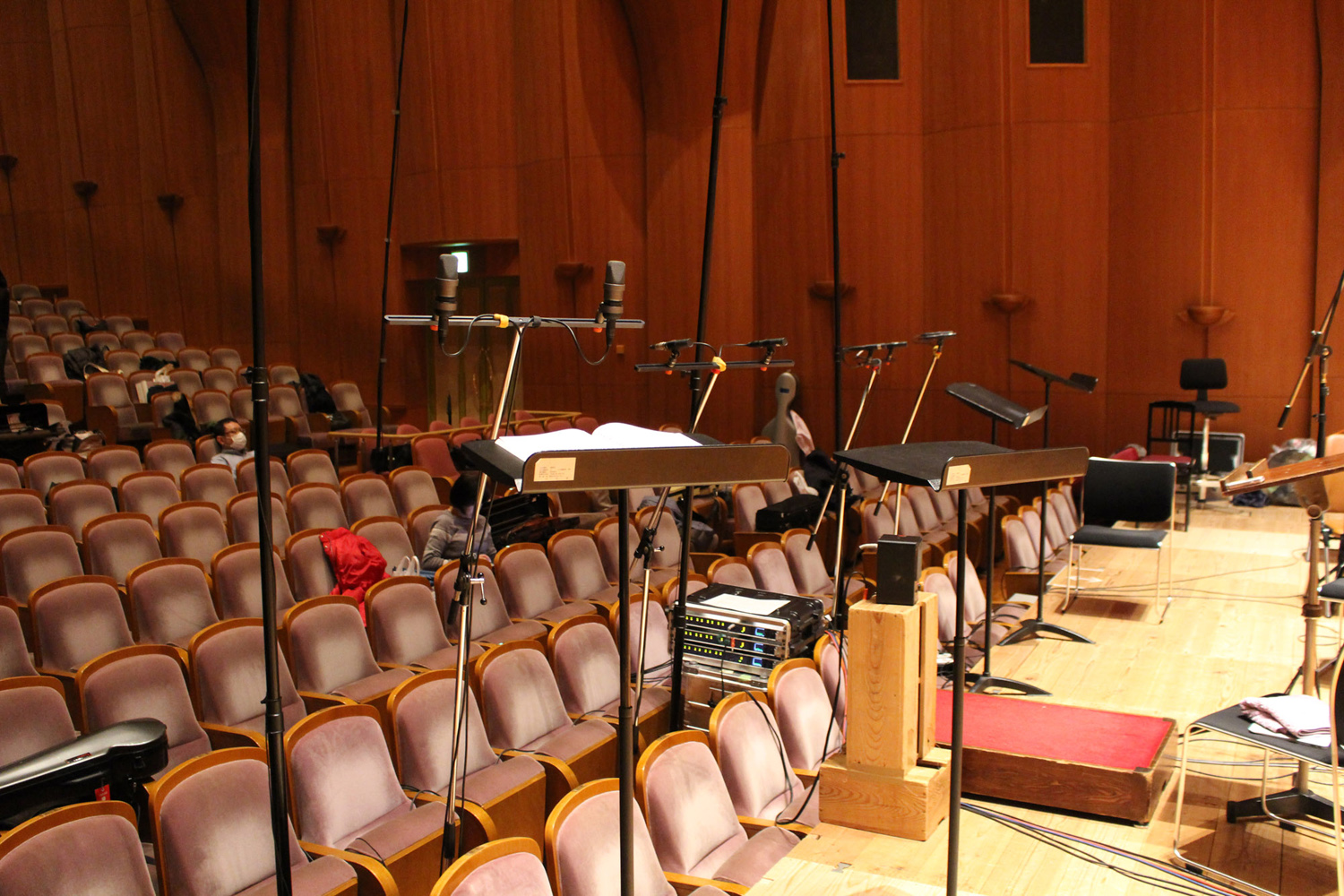 |
| Hall at Kawaguchi Cultural Center Lilia | Main L-C-R Mic with conductor and Solist | Stereo Spot mic for the Solo |
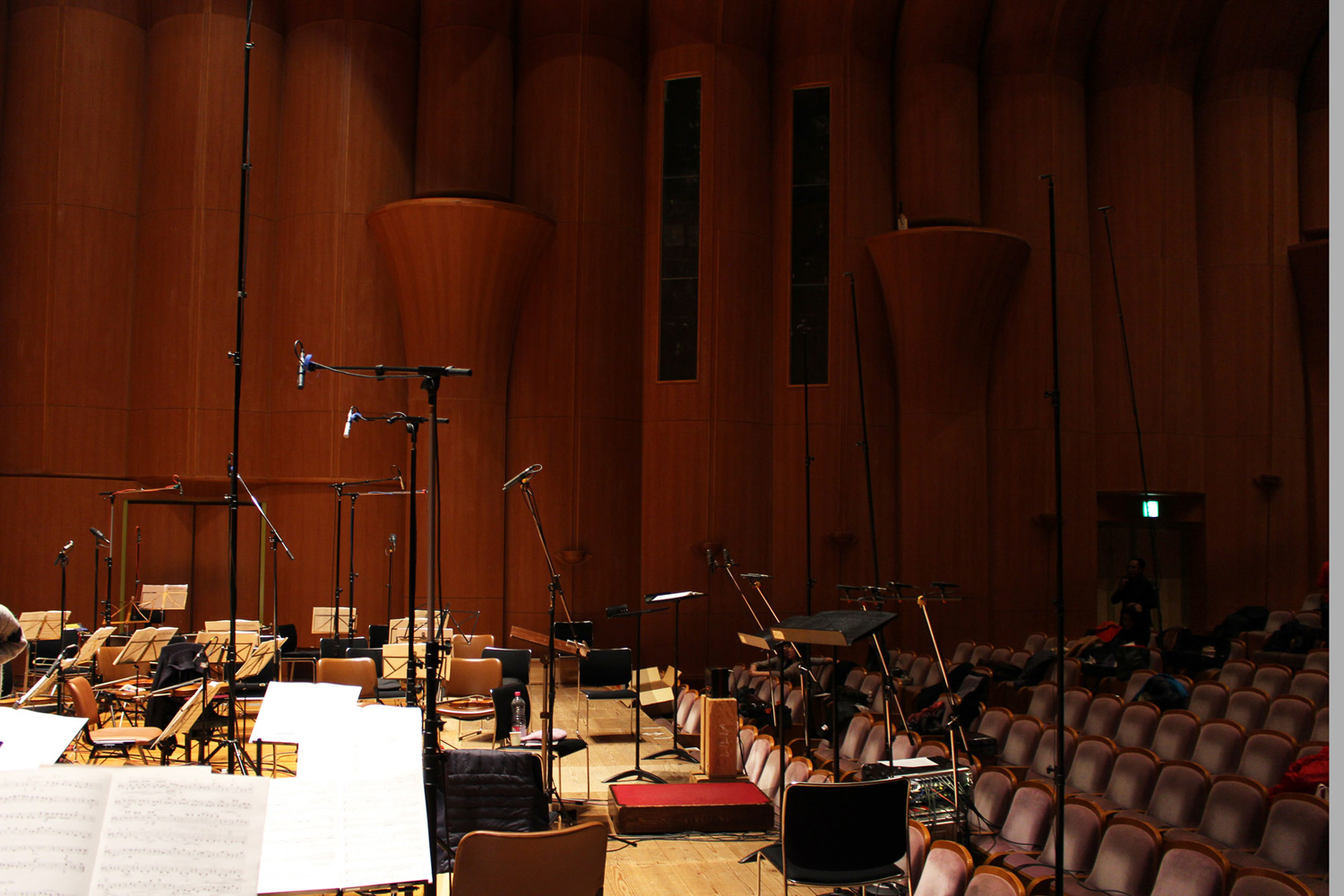 |  | 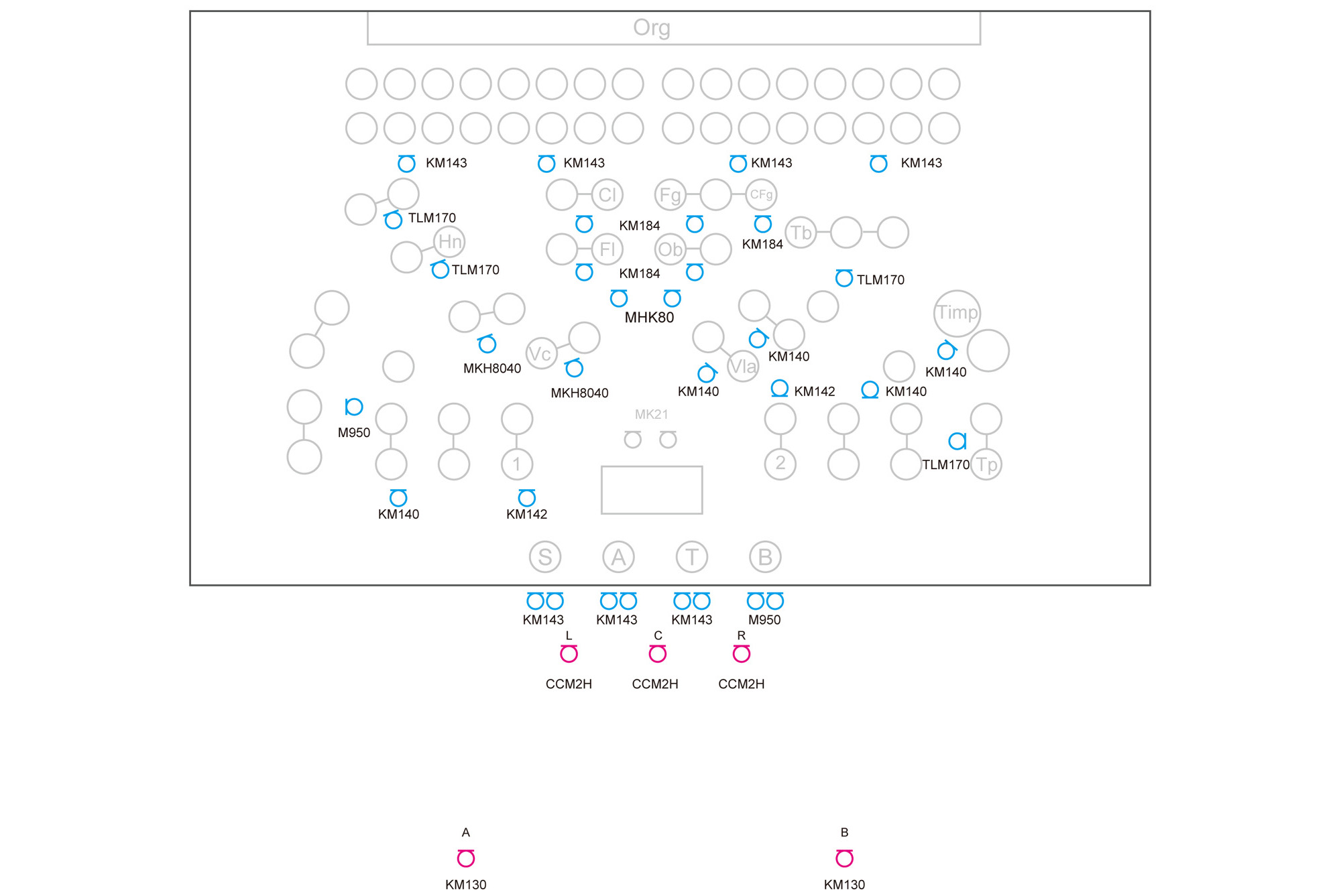 |
| Side view of the Main mic | Tonmeister, Matthias Spitzbarth | Set Up |
Interview :
I did a mail interview with following in July 2017.
CEO Mr.Robert von Bahr
 Q. I think that the BIS record that continues releasing 5 classical music CDs every month is extremely energetic even from all over the world, and the contents of the work are also so fantastic. Please let us know your philosophy about carrying out the music label. What is the secret? Please tell us about future ambitions of BIS in the future.
Q. I think that the BIS record that continues releasing 5 classical music CDs every month is extremely energetic even from all over the world, and the contents of the work are also so fantastic. Please let us know your philosophy about carrying out the music label. What is the secret? Please tell us about future ambitions of BIS in the future.
A. There are no secrets. BIS consists of staff, who genuinely love music and are fanatics about quality all round. There are still very many really worthwhile pieces of music undiscovered, and there are so many really fantastic artists coming along. The problem isn't to find good things to do - the problem is to limit ourselves to what we actually can produce, without letting any of the quality aspects suffer.
Producer, Mr.Robert Suff
Q. Please let me know your career profile?
 A. After graduating with a Master of Music degree in Music Theory and Analysis from King's College London in 1988, my ambition was to become a conductor but while figuring out the best way to proceed, I needed a secure job to ensure a steady income. I felt that my score-reading ability and interest in interpretation would be the ideal qualifications for a recording producer and decided to apply for an appreneticship at various labels. I received the most positive response from Robert von Bahr, who invited me to work for BIS in 1989 and, except for a short episode working as a freelance producer in the mid-90s, I have been there ever since. As BIS had expanded enormously throughout the 1990s, Robert asked me in 1999 to coordinate the artistic planning (in addition to my work as a producer) and since 2003 I have been Artist and Repertoire Director with responsibility for planning all recordings, negotiating artist contracts and developing long-term recording strategies for the leading BIS artists. I still produce a few recordings every year, primarily large-scale orchestral repertoire with a select handful of conductors. Osmo Vänskä is my closest collaborator - we have worked together since 1992! - and I have recently embarked on rewarding collaborations with Kent Nagano and Susanna Mälkki.
A. After graduating with a Master of Music degree in Music Theory and Analysis from King's College London in 1988, my ambition was to become a conductor but while figuring out the best way to proceed, I needed a secure job to ensure a steady income. I felt that my score-reading ability and interest in interpretation would be the ideal qualifications for a recording producer and decided to apply for an appreneticship at various labels. I received the most positive response from Robert von Bahr, who invited me to work for BIS in 1989 and, except for a short episode working as a freelance producer in the mid-90s, I have been there ever since. As BIS had expanded enormously throughout the 1990s, Robert asked me in 1999 to coordinate the artistic planning (in addition to my work as a producer) and since 2003 I have been Artist and Repertoire Director with responsibility for planning all recordings, negotiating artist contracts and developing long-term recording strategies for the leading BIS artists. I still produce a few recordings every year, primarily large-scale orchestral repertoire with a select handful of conductors. Osmo Vänskä is my closest collaborator - we have worked together since 1992! - and I have recently embarked on rewarding collaborations with Kent Nagano and Susanna Mälkki.
Q. Please let me know your philosophy of the music production of the sound and music.
A. This is a difficult question to answer! Like all producers I try to help artists perform to the best of their capabilities in the studio by offering detailed and constructive criticism after each take and helping them project their interpretations in the best possible light. While of course trying to make a recorded performance sound as engrossing as a thrilling concert performance, we are talking about two different art forms. I see the role of a recording producer as being akin to that of a film director. Both use their sessions to collect as much excellent material as possible by encouaraging and inspiring the artists to take risks and then edit the recorded material carefully to create a performance that optimizes all the elements that combine to make a great recording - the interpretation, the technical quality of the music making, concentration on the subtle details in a score that many are happy to gloss over, a well-balanced and exciting sound picture etc. But for this to be successful you need a clear vision of what you are hoping to achieve otherwise you can end up tying yourself in knots! The best recordings are those that offer the same level of musical and emotional satisfaction as a live performance but which add a level of perfection in the playing and sound balance that is almost impossible to achieve in a concert situation.
Take 5 Music Production, Mr.Tonmeister Thore Brinkmann,
Q. Please let me know your career profile?
A. My first interest in the profession came when a friend gave me some information about the Tonmeister courses in Detmold and Berlin. I was interested because the studies included both the fields of physics, and especially electronics, as well as gave a five years of instrumental and theoretical training in music. I had been worried that my eagerness to practice the piano or cello for many hours on a daily basis throughout a lifetime would not be lasting enough to become a professional musician. Within a few month I had realized that I had found my calling.
A. My first interest in the profession came when a friend gave me some information about the Tonmeister courses in Detmold and Berlin. I was interested because the studies included both the fields of physics, and especially electronics, as well as gave a five years of instrumental and theoretical training in music. I had been worried that my eagerness to practice the piano or cello for many hours on a daily basis throughout a lifetime would not be lasting enough to become a professional musician. Within a few month I had realized that I had found my calling.
Being born in Germany but having a Norwegian mother I had always been keen on moving to Scandinavia. During summer breaks I applied for an internship at the Norwegian Broadcast Company as well as BIS besides WDR Köln, Deutsche Grammofon and Hanover Opera House which were the common places to visit. Near the end of my Tonmeister studies in Detmold I even spent one year to study Norwegian and Musicology at University of Oslo. During this time I was also guest at the Norwegian Academy of Music and had full access to their studios.
When I had graduated in Detmold 1997 Clement Spiess and Koichiro Hattori got me interested in a 50% position at their company Soundarts AG in Switzerland. They had recently bought the Swiss label PAN classics and had started releasing a CD almost every month and worked for the Swiss Radio, as well. Together we did the first ever CD recordings at the new concert hall in Luzern https://www.kkl-luzern.ch/de/. At the time we actually already produced everything in 24/96 using DCS converters and GENEX M.O.D., only there wasn't a way to release it because High Res donwloads and SACD had not yet been invented. The other half of my time I spent freelancing at Floating Earth in London, BIS in Stockholm plus trying to get a permanent foot into Norway. Then one day in 2000 Robert von Bahr offered me to join the BIS-Team full time.
My first Job was to plan the new BIS studios which you have seen and presented and get them running. The second was to develop the logistical capabilities of BIS and to re-organize the recording equipment. Until then almost every recording had been started in a Volvo in Stockholm and my colleagues and I still spent days of travellling all the way to western Norway and England by car. Today we always send equipment ahead of time.
Since we have founded Take5 I have also started to work as producer for the Danish Radio Symphony Orchestra in Copenhagen on a regular basis.
Q. Please let me know your philosophy of the music production of the sound and music.
A. A Producer has to be flexible and adjust to the needs each musician very quickly. It is the musician who should interpret the music and if we manage to gain trust and present the right balance of good / clear instructions and humbleness and understanding for the difficulties of playing an instrument on a high level we get the best interpretations. Therefore it is important that we have been practicing and struggling with an instrument ourselves. A recording is a stressful situation, because the result will be captured and stored maybe for ever. There normally is no audience so we have to be the motivating person. It is a very important fact that someone is listening with all his or her mind and heart on the other side of the microphone. Not just press the record button.
Naturally one needs to prepare as well as possible, but as many will know there is never enough time and money in culture, we do it, because we love it.
A very good sense/experience for musical style is important to be a good musical guide, but also to create the right type of sound that will match the music. Recording all over the world I have learned to respect different taste of musicians regarding how rich(reverb) or how dry a sound should be, still being a very good recording. Also I want to be true to my own sound ideal. Maybe recently I am using less reverb/acoustic, because I have worked with some very good musicians who like it that way. But also different types instruments and music have different needs.
I want to create a sound picture that has both depths and a rich and warm closeness to each instrument. Sometimes it can be in a reverberant acoustic and sometimes it is better in a dryer place. In any case, enough direct sound that touches us emotionally - not too far from the audience - but with the right amount of space around it, never hearing the microphone, but just the source. This is more so the smaller the ensemble is, of course. But for instance the Mahler Symphonies are so full of details that it is important to catch the clarity of each line and integrate it in a total picture that has both impact/power, closeness and distance where it is demanded by Mahler. If everything becomes distant, then where is the effect if something is really distant?
Also that is the way the Minnesota Orchestra sounds at Minnesota Hall. It is a Large Hall in Shoebox design, but very clear. We listened to 2 concerts before starting the recording.
Q. On the recording of Missa solemnis, at the the surround, It makes AB is LS - RS. Please tell
us the your decision of main mic system with Stereo and surround.
A. We are idealistic people, but we have the engineer side and sometimes we need to be practical. As you can see we are using a lot of microphones, which doesn't mean that one should hear any microphone at all. It is important to be consistent. If I only put a spot microphone where I really "need" it for balance, there is a good chance, that I can HEAR that microphone. Of course there are ways to solve that problem and engineers working this way are very skillfully avoiding it. But we may have different ideals in terms of the overall result of the recording. To achieve my ideal I can not forget any instruments in my microphone plan. Sometimes I really don't want to loose a microphone in the orchestra (or choir), but like in the case of the Missa I really want that extra distant AB/ for the Stereo Mix, so I decide to place the KM130 high enough or far enough away that they will fulfill both purposes, maybe I need to reduce the treble boost which is +8dB at 8hHz on a KM130 a bit for the 5ch mix, but it is a compromise worth making if I can achieve a better Stereo Mix.
Bach Collegium Japan (BCJ) Conductor Mr. Masaaki Suzuki.
 Q. I think that recording of the complete collection of Bach: Church Cantata series so fantastic works that other labels and playing organizations ever could not it. How you feel the production with BIS and Take 5.
Q. I think that recording of the complete collection of Bach: Church Cantata series so fantastic works that other labels and playing organizations ever could not it. How you feel the production with BIS and Take 5.
A. In May 1995, BCJ was recorded the first time with BIS at Kobe Shoin Women’s University Chapel. Mr. von Bahr was the producer. Mr. Kipfer was the balance engineer. In the early works of the BIS, Mr. von Bahr served as a producer, after that, together with the Tonmeisters of BIS and the current Take 5. We worked together with works of 60 or more CDs, we made an opinion to make it a best work I have bumped into each other. Today, it is an era when we can communicate instantaneously with email, but in the 1990 's we used facsimile. I sent few lines of sentence sent to BIS via fax. then came back with does not end like a waterfall. It is a very good memory for us. The Recording is to record the sound, it is a physical matter itself, but after all our musicians interpret the music from the score and think that we want to represent the most suitable, so they I would like to create the sound as music in its best. Tonmeister has not only the technically but also the music understanding exactly the same as the conductor and the performance ability as well as the performer. When the recording, Tonmeister give us some remarks which is good or not good of the performance. Sometimes they also propose to us the phrase singing and the meaning of that sound for the chord. However, Tonemeister understands that these works are not own works ''It is a artists works''. There is a so much of the elements in the recording, how to organize, record, edit, mix and finishing, but recording can not be done with our performers alone. They are our irreplaceable partners.
Conclusion :
This time, I could visit BIS’s head office thanks to various connections. It is just less than 2 hours of flight from Düsseldorf, a city near Cologne, where the Tonmeister Convention was held, to Stockholm on LLC, and it costs less than 50 euros for one way.
We hear various media reports about the future of EU. However, there is no passport control, and we can come and go everywhere just like traveling in one country now. A record company in this area have free access to all regions in Europe, so the company can deliver music from those areas to all over the world. BIS and Take5 are separate companies, but to me, it looked like they have such a wonderful relationship.
About these companies being separate organizations, Mr. Brinkman told me, "We have a positive meaning that I can be responsible for the production of BIS's work as well as at the same time I can be responsible for the production of other labels.” From these words, I felt that what is important for current recording production scenes is that individual skills of producers and engineers are respected.
I asked him, "Why company name is Take 5? 5 persons?", and he answered, "Yes, and we record less than Take 5." I do not forget this nice joke.
I am deeply grateful to each member of BIS and Take5, Mr. Masaaki Suzuki and Bach Collegium Japan for providing us with so much information about their works and philosophies. I would also like to express my gratitude to Mr. Tetsuro Kanai at Tonmeister Course, Detmold University of Music for mediating between us. Thank you very much.
More information
This report was originally contributed to Japanese PROSOUND on Oct 2017, Vol.201 issue.
Japanese to English translate supported by Hitoshi Sugie.


